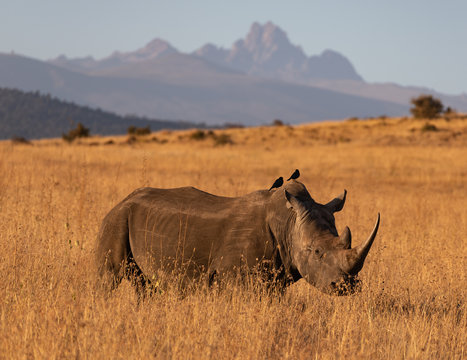Mount Kenya National Park is a UNESCO World Heritage Site located in central Kenya. The park encompasses the area around Mount Kenya, Africa’s second-highest peak, which rises to an elevation of 5,199 meters (17,057 feet). The park is renowned for its stunning landscapes, diverse ecosystems, and the challenging yet rewarding trekking and climbing opportunities it offers.
Features and Highlights
-
Mount Kenya: The park’s centerpiece is Mount Kenya, an extinct stratovolcano with three main peaks: Batian (5,199 meters), Nelion (5,188 meters), and Point Lenana (4,985 meters). Batian and Nelion require technical climbing skills, while Point Lenana is accessible to trekkers.
-
Diverse Ecosystems: The park boasts a wide range of habitats, from montane forests and bamboo zones to alpine moorlands and glacial peaks. This diversity supports a variety of flora and fauna.
-
Flora: The lower slopes are covered in dense forests with bamboo and giant heather, while higher altitudes feature unique alpine vegetation, including lobelias and giant groundsels.
-
Fauna: Wildlife in the park includes elephants, buffaloes, leopards, hyenas, and various antelope species. The park is also home to numerous bird species, such as the endangered Abbott’s starling and the Jackson’s francolin.
-
Scenic Landscapes: The park offers breathtaking scenery, including glacial lakes, rugged peaks, deep valleys, and waterfalls. The views from the mountain are spectacular, especially during sunrise and sunset.
Getting There
-
By Road: Mount Kenya National Park is accessible by road from Nairobi, which is about a 3-4 hour drive. The main entry points are Naro Moru, Sirimon, and Chogoria Gates. The roads to the park gates are generally in good condition.
-
By Air: The nearest airport is Nanyuki Airstrip, which is about a 45-minute flight from Nairobi. From Nanyuki, it is a short drive to the park.
Best Time to Visit
Mount Kenya National Park can be visited year-round, but the best times for trekking and climbing are during the dry seasons:
- January to February: The weather is dry and clear, making it an ideal time for trekking and climbing.
- July to October: Another dry period that offers good conditions for trekking and climbing.
The wet seasons (March to June and November to December) can make trekking more challenging due to muddy trails and reduced visibility, but the park is lush and vibrant during these times.





Activities
- Trekking and Climbing: The most popular activity in the park is trekking to the peaks of Mount Kenya. The trek to Point Lenana is the most accessible and can be completed without technical climbing skills. The Sirimon, Naro Moru, and Chogoria routes are the main trekking paths. Technical climbs to Batian and Nelion require advanced climbing skills and equipment.
- Wildlife Viewing: Game drives and guided walks in the lower slopes offer opportunities to see wildlife such as elephants, buffaloes, and various antelopes.
- Bird Watching: The park is a haven for birdwatchers, with over 130 bird species recorded. Guided birdwatching tours can help spot and identify the diverse avian life.
- Camping: There are several designated camping sites in the park, providing a chance to experience the mountain’s wilderness up close.
- Scenic Walks and Hikes: Besides the main trekking routes, there are shorter walks and hikes in the forested lower slopes, offering beautiful scenery and opportunities to explore the unique flora and fauna.
Accommodations
Accommodations around Mount Kenya National Park range from luxury lodges to budget campsites:
- Luxury Lodges:
- Fairmont Mount Kenya Safari Club: Located near Nanyuki, this luxurious lodge offers elegant accommodations and stunning views of Mount Kenya.
- Serena Mountain Lodge: Situated on the slopes of Mount Kenya, this lodge offers comfortable rooms and excellent wildlife viewing from its treehouse-like structure.
- Mid-Range Lodges and Camps:
- Naro Moru River Lodge: A popular base for trekkers, offering comfortable accommodations and a range of facilities.
- Bantu Lodge: Located near the Sirimon Gate, offering cozy cabins and easy access to trekking routes.
- Budget Camps and Cottages:
- Old Moses Camp: A basic campsite on the Sirimon route, providing shelter and facilities for trekkers.
- Met Station: A popular starting point for the Naro Moru route, offering basic accommodation and camping facilities.
Trekking Routes
- Sirimon Route: Known for its gradual ascent and beautiful scenery, the Sirimon route starts at Sirimon Gate and passes through montane forests and moorlands. It is often combined with the Chogoria route for a scenic trek.
- Naro Moru Route: The most popular and shortest route to Point Lenana, known for its steep sections and the challenging “Vertical Bog.” It offers a direct path to the peak.
- Chogoria Route: Renowned for its stunning landscapes, including Lake Michaelson and the Gorges Valley. It is often considered the most scenic route and is typically combined with the Sirimon route.
- Burguret Route: A less frequented route that offers a more rugged and remote trekking experience, passing through dense forests and moorlands.
Mount Kenya National Park offers a unique and unforgettable adventure for nature lovers, trekkers, and climbers. Whether you’re seeking the challenge of summiting its peaks, the beauty of its diverse ecosystems, or the serenity of its landscapes, Mount Kenya provides a truly exceptional experience in the heart of Kenya.








